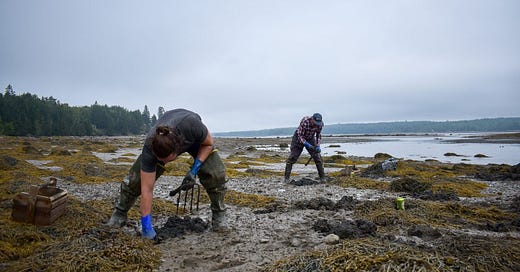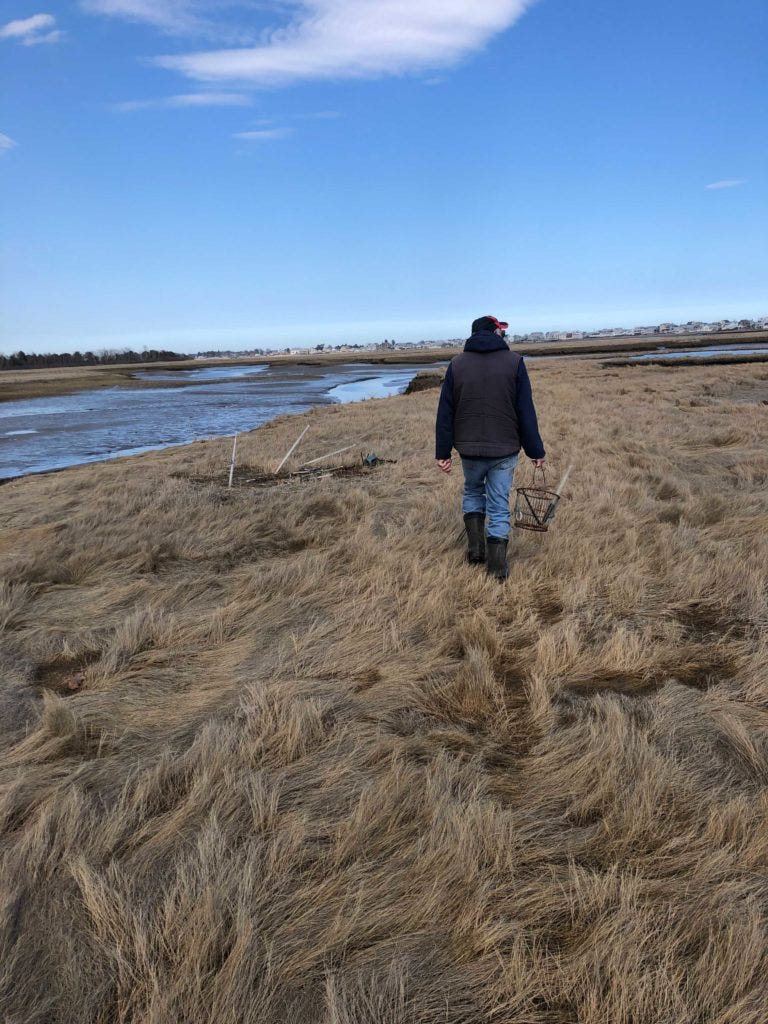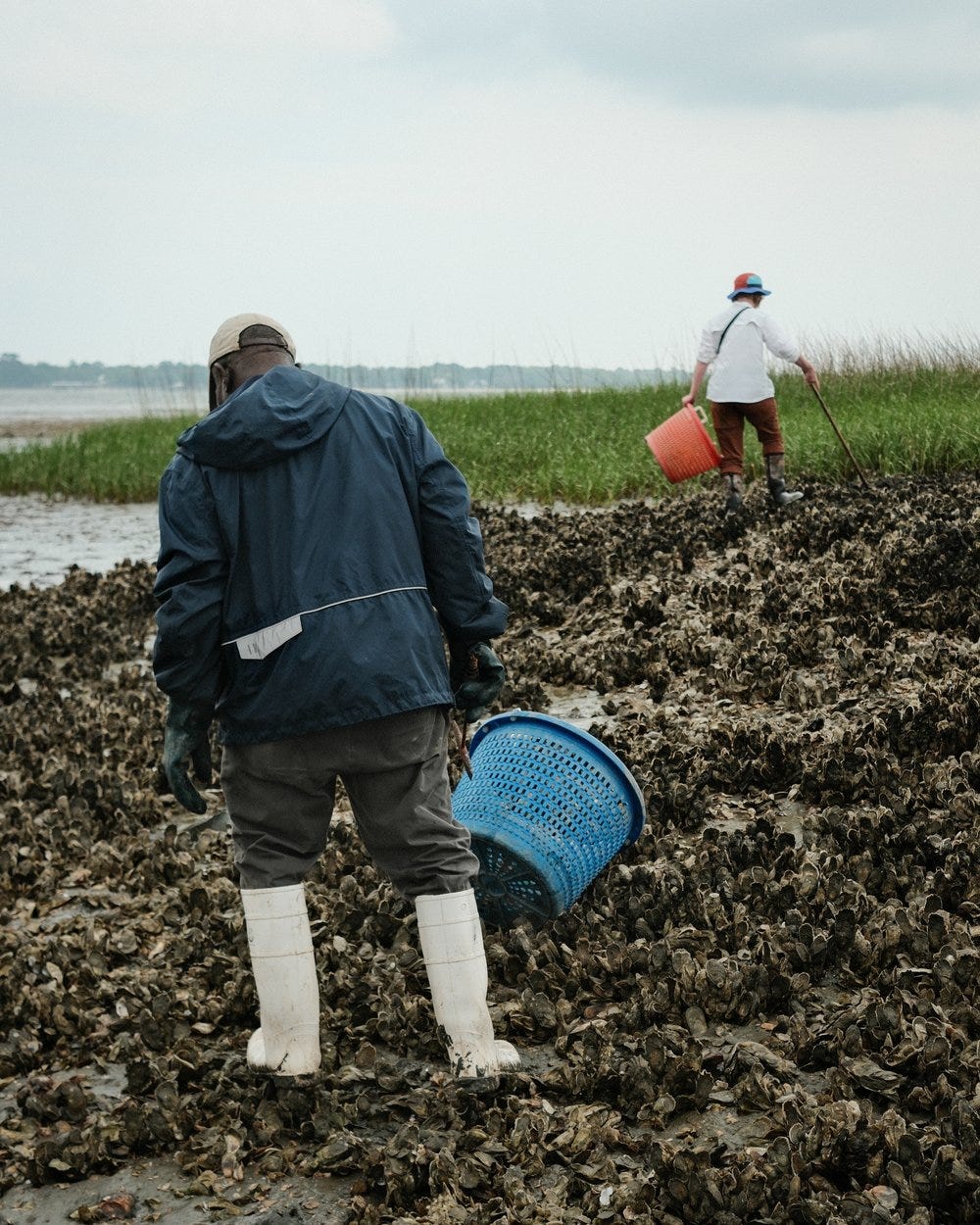Raise Clams, Not Subdivisions
Hold onto your beer and oysters, let's explore Southern clam culture.
Late spring in New England, when the waters of the bay start warming up and oyster season begins to wane, mullusk lovers start to clamor for clams. I loved lacing up my boots and walking onto the foggy beach with seabirds flying overhead and the sound of ocean thunder crashing against the shore. That day, I had a chance to meet with true downeasters and learn how to dig for clams.
My first time digging for clams was on the coast of Narragansett Bay. In New England, you can recreationally harvest eight quarts of clams every day. Just like with fishing and lobstering, there are legal size limits to abide by. If you’re lucky, you’ll hit what’s called “a run” and find yourself filling up your basket or bucket with more than enough for dinner. Then, you can boast about gleaning one of the state’s true wild foods.
Here’s what to do whenever you want to find clams.
Shellfish biologist Denis-Marc Nault, supervisor of Maine’s shellfish management program, told me the ideal locations would be in water that’s waist deep or slightly deeper at high tide. “As a general rule of thumb, the farther you get from civilization, the better. Not only is it easier to meld with the natural world, there will be less competition and hence, more clams,” says Denis.
Edges of partially submerged marsh islands, and the mouths of creeks and cuts going back into a salt marsh are good spots. If you don’t have a handful of clams after the initial investigation, move on.
What to take and what to look for.
The best time to go is on a falling tide, at low tide, or at the early stages of the incoming tide; in other words, when there’s more land than water. As for equipment, all you need is some form of basket or bucket and a clam fork—a four or five-tined, bent fork with a stubby handle.
Scan the mud or sand for holes, which will be scattered along the flat. “It’s kind of an oblong hole, not a round hole,” says Nault. “And there are two holes: from the incurrent and excurrent syphon in the clam’s neck.” Dig in front of the holes, carefully peeling through the layers of mud to get to the clams without breaking their shells.
The same is true in the South Carolina Lowcountry, where I once went clamming with Craig Reaves, a second-generation waterman.
I stayed on the boat watching Craig and his men go deep into the high marsh grass just off Hilton Head Island. “When I was a boy, mama would go in here with me and tuck the clams into her bathing suit,” said Craig.
I could see the edges of clam shells reaching up from the piquant pluff mud between the tall Spartina grasses. Craig and his men soon returned to the boat with baskets heavy with clams.
Digging for Clams
Beachgoers head to Hilton Head much as they do in the Cape, walking with their bucket in hand to gather shells rather than clams. Southern clambakes, if they exist at all, are not the stuff of American holidays and Fourth of July picnics.
Clamming continues in fishing villages where locals know where clams seek refuge. This can result in an honest day’s work, filling freezers and church coffers, but they are not a boastful crowd. It appears they cannot compete with the oysters’ charm.
Around Charleston and the SC Lowcountry, Dave Belanger is rarely called by his given name. He’s known as Clammer Dave, thanks to the Caper’s Clams he’s been raising for a decade. His clams come from the barrier Island waters along Capers Island Wildlife Refuge just north of Charleston, and they’re some of the best.
Oldtimers along the docks in Port Royal, SC, know how to search for clams. In dry white sand, when the sun is coming up, they look for “clam spit”, also known as sea silk, referring to the thread-like filaments secreted by certain clams which they use to attach themselves to rocks.
When it’s hot, they crawl through the sand and leave a telltale lump. As the tide starts coming in, clams spit underwater, which form a keyhole-shaped indentation in the sand. Walking along the beaches in Hilton Head, one can see the indentations everywhere.
Behind the Kitchen Door, a collection of local recipes for paid subscribers and all who wish to subscribe.
There’s a plethora of Lowcountry dishes that start and end with seafood, potato, onions, water, and cornmeal dumplings. Today we feature Coosaw Cioppini, Courtesy of Poseiden, Hilton Head Island, and Michael Anthony’s Cucina Italiana
Keep reading with a 7-day free trial
Subscribe to The Diary of Southern Lifestyle Author Pat Branning to keep reading this post and get 7 days of free access to the full post archives.







